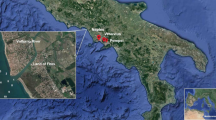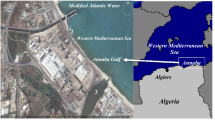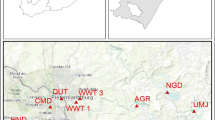Abstract
The Umgeni River is one of the main sources of water in KwaZulu-Natal, South Africa; however; there is currently a lack of information on the presence and distribution of polychlorinated biphenyls (PCBs) in its sediment, sediment pore water and surface water. This study aims to determine the occurrence and significance of selected PCBs in the surface water, sediment pore water and surface sediment samples from the Umgeni River. Liquid-liquid and soxhlet extractions were used for water or pore water, and sediments, respectively. Extracts were cleaned up using a florisil column and analysed by gas chromatography-mass spectrometry. The total concentrations of eight polychlorinated biphenyls were 6.91–21.69 ng/mL, 40.67–252.30 ng/mL and 102.60–427.80 ng/g (dry weight), in unfiltered surface water, unfiltered sediment pore water and surface sediments, respectively. The percentage contributions of various matrices were 4, 36 and 60 % for unfiltered surface water, unfiltered pore water and sediment, respectively. The highest concentrations of PCBs were found in water, pore water and sediment collected from sampling sites close to the Northern Wastewater Treatment Works. The highest chlorinated biphenyl, PCB 180, was the most abundant at almost all sampling sites. To our knowledge, this is the first report on occurrence of polychlorinated biphenyls in the Umgeni River water, pore water and sediment system and our results provide valuable information regarding the partitioning of the PCBs between the water and sediment systems as well as the organic chemical quality of the water.






Similar content being viewed by others
References
Ankley, G. T., & Schubauer-Berigan, M. K. (1994). Comparison of techniques for the isolation of sediment pore water for toxicity testing. Archives of Environmental Contamination and Toxicology, 27, 507–512.
Aparna, B., Nathan, H. L., & Hanadi, R. S. (2014). Polychlorinated biphenyls (PCBs) in industrial and municipal effluents: concentrations, congener profiles, and partitioning onto particulates and organic carbon. Science of the Total Environment, 473–474, 702–713.
APHA, AWWA & WEF. (1999). Standard methods for the examination of water and wastewater [online]. American Public Health Association; American Water Works Association and Water Environmental Association. Available: www.mwa.co.th/download/file_upload/SMWW_1000-3000.pdf. Accessed 4 Aug 2014.
Bazzanti, M., Chiavarini, S., Crimiseni, C. & Soldati, P. (1997). Distribution of PCB congeners in aquatic ecosystems: A case study. Environmental International, 23, 799--813.
Binning, K., & Baird, D. (2001). Survey of heavy metals in the sediments of the Swartkops River estuary, Port Elizabeth, South Africa. Water SA, 27, 461–466.
Brown, J. F., Bedar, D. L., Brennan, M. J., Granhan, J. C., Feng, H., & Wagner, R. E. (1987). Polychlorinated biphenyl dechlorination in aquatic sediments. Science, 236, 709–712.
Carro, N., Garcia, I., Ignacio, M., & Mouteira, A. (2002). Levels and distribution patterns of polychlorinated biphenyl congeners in surface sediments from Galicia coast (North-Western, Spain) according to granulometric characteristics. Journal of Environmental Technology, 23, 919–930.
CCME. (2002). Canadian sediment quality guidelines for the protection of aquatic life [online]. Canadian Council of Ministers of the Environment. Available: http://www.pla.co.uk/Environment/Canadian-Sediment-Quality-Guidelines-for-the-Protection-of-Aquatic-Life. Accessed 29 Aug 2014
Chang, B. V., Liu, W. G., & Yuan, S. Y. (2001). Microbial dechlorination of three PCB congeners in river sediment. Chemosphere, 45, 849–856.
Chevreuil, M., & Granier, L. (1985). Seasonal cycle of polychlorinated biphenyl in the waters of the catchment basin of the river Seine (France). Aquatic Toxicology, 7, 217–229.
Cohn, A. B., Cirillo, M. P., Sholtz, I. R., Ferrara, A., Parkc, J.-S., & Schwingl, J. P. (2011). Polychlorinated biphenyl (PCB) exposure in mothers and time to pregnancy in daughters. Reproductive Toxicology, 31, 290–296.
Daouk, T., Larcher, T., Roupsard, F., Lyphout, L., Rigaud, C., Ledevin, M., Loizeau, V., & Cousin, X. (2011). Long-term food-exposure of zebrafish to PCB mixtures mimicking some environmental situations induces ovary pathology and impairs reproduction ability. Aquatic Toxicology, 105, 270–278.
DE Voogt, P., Wells, D. E., Reutergardh, L., & Brinkman, U. A. T. (1990). Biological activity, determination and occurrence of planar, mono-ortho and di-ortho PCBs. International Journal of Environmental Analytical Chemistry, 40, 1–46.
De, S., Perkins, M., & Dutta, S. K. (2006). Nitrate reductase gene involvement in hexachlorobiphenyl dechlorination by Phanerochaete chrysosporium. Journal of Hazardous Materials, B135, 350–354.
Dragan, D., Cucu-Man, S., Dirtu, A. C., Mocanu, R., Vaeck, L. V., & Covaci, A. (2006). Occurrence of organochlorine pesticides and polychlorinated biphenyls in soils and sediments from Eastern Romania. International Journal of Environmental Analytical Chemistry, 86, 833–842.
EC. (1999). EU commission decision 1999/788/EC of 3 December 1999 on protective measures with regard to contamination by dioxins of certain products of porcine and poultry origin intended for human or animal consumption. Official Journal of the European Union, L310, 62–70.
EPA. (1996a). Method 3510 C, separatory funnel liquid-liquid extraction [online]. Available: http://www.epa.gov/osw/hazard/testmethods/sw846/pdfs/3510c.pdf. Accessed 9 Aug 2014.
EPA. (1996b). Method 3540C: soxhlet extraction [online]. Available: http://www.epa.gov/osw/hazard/testmethods/sw846/pdfs/3540c.pdf. Accessed 10 Mar 2014.
EPA. (2007). Method 3620: florisil cleanup [online]. Available: http://www.epa.gov/osw/hazard/testmethods/sw846/pdfs/3620c.pdf. Accessed 10 Mar 2014.
Fatoki, O. S., & Awofolu, O. R. (2003a). Levels of Cd, Hg and Zn in some surface waters from the Eastern Cape Province, South Africa. Water SA, 29, 375–380.
Fatoki, O. S., & Awofolu, O. R. (2003b). Persistent organochlorine pesticides residues in freshwater systems and sediments from the Eastern Cape, South Africa. Water SA, 29, 323–330.
Fatoki, O. S., Bornman, M., Ravandhalala, L., Chimuka, L., Genth, B., & Adeniyi, A. (2010). Phthalate ester plasticizers in freshwater systems of Venda, South Africa and potential health effects. Water SA, 36, 117–125.
Gioia, R., Akindele, A. J., Adebusoye, S. A., Asante, K. A., Tanabe, S., Buekens, A., & Sasco, A. J. (2014). Polychlorinated biphenyls (PCBs) in Africa: a review of environmental levels. Environmental Science Pollution Research, 21, 6278–6289.
Harry, B. M., Lynn, S. W. & Judith, A. S. (2008). Alternative approaches to collecting and interpreting matrix spike data. 27th annual EPA conference on managing environmental quality systems [online]. Available: http://www.epa.gov/QUALITY/qs-2008/alternative.pdf. Accessed 12 June 2014.
Hellar-Kihampa, De Wael, K., Lugwisha, E., Malarvannan, G., & Covacid, A. R. V. G. (2013). Spatial monitoring of organohalogen compounds in surface water and sediments of a rural–urban river basin in Tanzania. Science of the Total Environment, 447, 186–197.
Iwata, H., Tanabe, S., Sakai, N., Nishimura, A., & Tatsukawa, R. (1994). Distribution of persistent organochlorines in the oceanic air and surface sea water and the role of ocean on their global transport and fate. Environmental Pollution, 85, 15–33.
Julia, F., Ralph, M., Sebastian, H., Evelyn, C. & S, C. E. W. (2012). Organic carbon source in formulated sediments influences life traits and gene expression of Caenorhabditis elegans. Journal of Ecotoxicology, 21, 557-568
Kanzan, F., Syakti, A. D., Asia, L., Malleret, L., Piram, A., Mille, G., & Doumenq, P. (2014). Distributions and sources of persistent organic pollutants (aliphatic hydrocarbons, PAHs, PCBs and pesticides) in surface sediments of an industrialised urban river (Huveaune). France Science of the Total Environment, 478, 141–151.
Karickhoff, S. W., Brown, D. S., & Scott, T. A. (1979). Sorption of hydrophobic pollutants on natural sediments. Water Research, 13, 241–248.
Katarzyńska, D., Hrabia, A., Kowalik, K., & Sechman, A. (2015). Comparison of the in vitro effects of TCDD, PCB 126 and PCB 153 on thyroid-restricted gene expression and thyroid hormone secretion by the chicken thyroid gland. Environmental Toxicology and Pharmacology, 39, 496–503.
Katsoyiannis, A., & Samara, C. (2004). Persistent organic pollutants (POPs) in the sewage treatment plant of Thessaloniki, Northern Greece: occurrence and removal. Water Research, 38, 2685–2698.
Katsoyiannis, A., & Samara, C. (2005). Persistent organic pollutants (POPs) in the conventional activated sludge treatment process: fate and mass balance. Environmental Research, 97, 245–257.
Ke-Xin, J., Bi-Xian, M., Guo-Ying, S., Jia-Mo, F., & Ping-an, P. (2003). Grain-size distribution of polychlorobiphenyls in sediments of the Pearl River. Diqiu Huaxue, 32, 606–612.
Kim, J. G., Kim, K. S., Oh, J. G., Choi, K. H., & Yoon, J. H. (2007). Sources of CO-PCBs in sediments of Han River in the South Korea. Organohalogen Compounds, 69, 551–554.
Kookana, R. S. (2011). The role of black carbon in environmental fate of persistent organic pollutants (POPs) in soils and their effect on food safety [online]. Australia: CSIRO Land and Water, PMB 2, Glen Osmond, 5064. Available: http://www.fftc.agnet.org/htmlarea_file/library/20110804154803/eb621.pdf. Accessed 22 Feb 2015.
Kumar, B., Kumar, S., & Sharma, C. S. (2013). Ecotoxicological risk assessment of polychlorinated biphenyl (PCBs) in bank sediments from along the Yamuna River in Delhi, India. Human and Ecological Risk Assessment, 19, 1477–1487.
Lauby-Secretan, B., Loomis, D., Grosse, Y., EL Ghissassi, F., Bouvard, V., Benbrahim-Tallaa, L., Guha, N., Baan, R., Mattock, H., & Straif, K. (2013). Carcinogenicity of polychlorinated biphenyls and polybrominated biphenyls. Lancet Oncology, 14, 287–288.
Li, J., Mgonella, K. M., Bzdusek, A. P., & Christensen, E. R. (2005). PCB congeners and dechlorination in sediments of Upper Sheboygan River, Wisconsin. Journal of Great Lakes Research, 31, 174–186.
Macdonald, C. R., Metclafe, C. D., Metcalfe, T., & Baltch, G. C. (1992). Temporal trends and distribution of PCB congeners in a small contaminated lake in Ontario Canada. In F. A. P. C. Gobas & J. A. Mccorqodale (Eds.), Chemical dynamics in freshwater ecosystems. Boca Raton: FL Lewis.
Manz, M., Wenzel, K. D., Dietz, U., & Schuurmann, G. (2001). Persistent organic pollutants in agricultural soil of central Germany. Science of the Total Environmental, 277, 187–198.
Matyas, R., Joanna, P., Joao, F., Cathrin, V., & Pete, H. (2015). Dissolved organic carbon quality and sorption of organic pollutants in the Baltic Sea in light of future climate change. Environmental Science & Technology, 49, 1445–1452.
Meharg, A. A., Wright, J., Leeks, G. J. L., Wass, P. D., Owens, P. N., Walling, D. E., & Osborn, D. (2003). PCB congener dynamics in a heavily industrialized river catchment. Science of the Total Environment, 314–316, 439–450.
Mowery, H. R. & Loganathan, B. G. (2007). Persistent organic compounds in wastewater: azithromycin and urobilin concentrations in wastewater treatment plant samples from Murray, Kentucky, USA [online]. Murray, USA: Department of Chemistry and Center for Reservoir Research, Murray State University, Murray, KY 42071-3346, USA. Available: http://campus.murraystate.edu/services/URSA/FINAL_PAPER_Holly_Mowery.pdf. Accessed 19 Aug 2014
Mwanamoki, P. M., Devarajan, N., Thevenon, F., Birane, N., de Alencastro, L. F., Grandjean, D., Mpiana, P. T., Prabakar, K., Mubedi, J. I., Kabele, C. G., Wildi, W., & Poté, J. (2014). Trace metals and persistent organic pollutants in sediments from river-reservoir systems in Democratic Republic of Congon (DRC): spatial distribution and potential ecotoxicological effects. Chemosphere, 111, 485–492.
Nhan, D., Carvarho, F., & Am, N. (2001). Chlorinated pesticides and PCBs in sediments and molluscs from freshwater canals in the Hanoi region. Environmental Pollution, 112, 311–320.
Olaniran, A. O., Naiker, K., & Pillay, B. (2014). Assessment of physical-chemical qualities and heavy metal concentrations of Umgeni and Umdloti Rivers in Durban, South Africa. Journal of Environmental Monitoring and Assessment, 186, 2629–2639.
Pegram, G. C., & Bath, A. J. (1995). Role of non-point sources in the development of a water quality management plan for the Mgeni River catchment. Water Science & Technology, 32, 175–182.
Pennington, D. W. (2001). An evaluation of chemical persistence screening approaches. Chemosphere, 44, 1589–1601.
Persaud, D., Jaagumagi, R. & Hayton, A. (1993). Guidelines for the protection and management of aquatic sediment quality in Ontario [online]. Ontario Ministry of Environment & Energy. Standard development branch and environmental monitoring and reporting branch. Available: http://www.itrcweb.org/contseds-bioavailability/References/guide_aquatic_sed93.pdf. Accessed 29 Aug 2014.
Perssona, N. J., Buchelia, T. D., Gustafssona, O., Bromana, D., Naesb, K., Ishaqa, R. & Zebuhra, Y. (2005). Testing common sediment-porewater distribution models for their ability to predict dissolved concentrations of POPs in The Grenlandsfjords, Norway. Chemosphere, 59, 1475--1485.
Pophali, G. R., Kaul, S. N., & Mathur, S. (2003). Influence of hydraulic shock loads and TDS on the performance of large-scale CETPs treating textile effluents in India. Water Research, 37, 353–361.
Quensen, J. F., Tiedje, J. M., & Boyd, S. A. (1988). Reductive dechlorination of polychlorinated biphenyls by anaerobic microorganisms from sediments. Science, 242, 752–754.
Rein, A., Fernqvist, M. M., Mayer, P., Trapp, S., Bittens, M., & Karlson, G. U. (2007). Degradation of PCB congeners by bacterial strains—determination of kinetic parameters and modelling of rhizoremediation. Applied Microbiology and Biotechnology, 77, 469–481.
Samara, F., Tsai, C. W., & Aga, D. S. (2006). Determination of potential sources of PCBs and PBDEs in sediments of Niagara River. Environmental Pollution, 139, 489–497.
Sapozhnikova, Y., Dawardi, O., & Schlenk, D. (2004). Pesticides and PCBs in sediments and fish from Salton Sea, California, USA. Chemosphere, 55, 797–809.
Ter Laak Thomas, L., H, V. E. J. C., M, B. F. J., Van Leeuwen Herman, P. & M., H. J. L. (2009). Facilitated transport of polychlorinated biphenyls and polybrominated diphenyl ethers by dissolved organic matter. Environmental Science and Technology, 43, 1379-1385.
Thwala, D. W. (2010). Community participation is a necessity for project success: a case study of rural water supply project in Jeppes Reefs, South Africa. African Journal of Agricultural Research, 5, 970–979.
USEPA. (1996). Method 3630, revision C [online]. Washington, DC, USA: US Environmental Protection Agency. Available: http://www.epa.gov/solidwaste/hazard/testmethods/sw846/pdfs/3630c.pdf. Accessed 20 May 2015.
USEPA (2008). Method 1668B chlorinated biphenyl congeners in water, soil, sediment, biosolids, and tissue by HRGC/HRMS. Quantitative determination. Washington, DC 20460: Office of Science and Technology Engineering and Analysis Division (4303T), 1200 Pennsylvania Avenue, NW
Verhaert, V., Covaci, A., Bouillon, S., Abrantes, K., Musibono, D., Bervoets, L., Verheyen, E., & Blust, R. (2013). Baseline levels and trophic transfer of persistent organic pollutants in sediments and biota from the Congo River Basin (DR Congo). Environment International, 59, 290–302.
Vosloo, R. & Bouwman, H. (2005). Survey of certain persistent organic pollutants in major South African waters [online]. Available: http://www.wrc.org.za/Knowledge%20Hub%20Documents/Research%20Reports/1213-1-05.pdf. Accessed 27 Feb 2015.
Xing, Y., Lu, Y., Dawson, R. W., Shi, Y., Zhang, H., Wang, T., Liu, W., & Ren, H. (2005). A spatial temporal assessment of pollution from PCBs in China. Chemosphere, 60, 731–739.
Zhang, Z. L., Hong, H. S., Zhou, J. L., Huang, J., & Yu, J. (2003). Fate and assessment of persistent organic pollutants in water and sediment from Minjiang River Estuary, Southeast China. Chemosphere, 52, 1423–1430.
Zhang, H., Zhao, X., Ni, Y., Lu, X., Chen, J., Su, F., Zhao, L., Zhang, N., & Zhang, X. (2010). PCDD/Fs and PCBs in sediments of Liaohe River, China: levels, distribution and possible sources. Chemosphere, 79, 754–762.
Zhang, L., Shi, S., Dong, L., Zhang, T., Zhou, L., & Huang, Y. (2011). Concentrations and possible sources of polychlorinated biphenyls in the surface water of the Yangtze River Delta, China. Chemosphere, 85, 399–405.
Zhao, X., Zheng, B., Qin, Y., Jiao, L., & Zhang, L. (2010). Grain size effect on PBDE and PCB concentrations in sediments from the intertidal zone of Bohai Bay, China. Chemosphere, 81, 1022–1026.
Zhou, W., Zhai, Z., Wang, Z., & Wang, L. (2005). Estimation of n-octanol/water partition coefficients (Kow) of all PCB congeners by density functional theory. Journal of Molecular Structure, 755, 137–145.
Acknowledgments
We wish to thank the University of KwaZulu-Natal (UKZN) and the Water Research Commission (WRC) of South Africa for financially supporting this project. We are also grateful to the School of Chemistry and Physics at UKZN for laboratory facilities.
Author information
Authors and Affiliations
Corresponding author
Electronic supplementary material
Below is the link to the electronic supplementary material.
ESM 1
(DOCX 365 kb)
Rights and permissions
About this article
Cite this article
Gakuba, E., Moodley, B., Ndungu, P. et al. Occurrence and significance of polychlorinated biphenyls in water, sediment pore water and surface sediments of Umgeni River, KwaZulu-Natal, South Africa. Environ Monit Assess 187, 568 (2015). https://doi.org/10.1007/s10661-015-4790-1
Received:
Accepted:
Published:
DOI: https://doi.org/10.1007/s10661-015-4790-1




